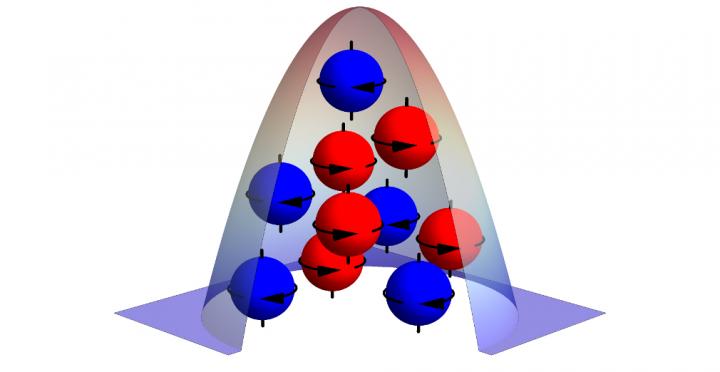Looking for dark matter with the universe's coldest material

Bose-Einstein condensate comagnetometer, formed by two distinct atomic internal states of 87Rb which are contained in the same spatial wavefunction. Credit: ICFO/ P. Gomez & M. Mitchell
In a new article published in Physical Review Letters and highlighted as an Editor's suggestion, ICFO researchers Pau Gomez, Ferran Martin, Chiara Mazzinghi, Daniel Benedicto Orenes, and Silvana Palacios, led by ICREA Prof. at ICFO Morgan W. Mitchell, report on how to search for axions using the unique properties of Bose-Einstein condensates (BECs).
The axion, if it exists, would imply “exotic spin-dependent forces.” Magnetism, the best-known spin-dependent force, causes electrons to point their spins along the magnetic field, like a compass needle that points north.
Magnetism is carried by virtual photons, whereas “exotic” spin-dependent forces would be carried by virtual axions (or axion-like particles). These forces would act on both electrons and nuclei, and would be produced not just by magnets, but also by ordinary matter. To know if axions do exist, a good way is to look and see if nuclei prefer to point toward other matter.
Several experiments are already searching for these forces, using “comagnetometers”, which are paired magnetic sensors in the same place. By comparing the two sensors' signals, the effect of the ordinary magnetic field can be cancelled out, leaving just the effect of the new force.
So far, comagnetometers have only been able to look for spin-dependent forces that reach about a meter or more. To look for short-range spin-dependent forces, a smaller comagnetometer is needed.
Bose Einstein Condensates (BECs) are gases cooled nearly to absolute zero. Because BECs are superfluid, their constituent atoms are free to rotate for several seconds without any friction, making them exceptionally sensitive to both magnetic fields and new exotic forces.
A BEC is also very small, about 10 micrometers in size. To make a BEC comagnetometer, however, requires solving a tricky problem: how to put two BEC magnetometers in the same small volume.
In their study, Gomez and his colleagues report that they were able to solve this problem by using two different internal states of the same 87Rb BEC, each one acting as a separate but co-located magnetometer.
The results of the experiment confirm the predicted high immunity to noise from the ordinary magnetic field and the ability to look for exotic forces with much shorter ranges than in previous experiments. Besides looking for axions, the technique may also improve precision measurements of ultracold collision physics and studies of quantum correlations in BECs.
###
Links of Reference:
Link to the paper: https:/
Link to the research group at ICFO https:/
Media Contact
All latest news from the category: Physics and Astronomy
This area deals with the fundamental laws and building blocks of nature and how they interact, the properties and the behavior of matter, and research into space and time and their structures.
innovations-report provides in-depth reports and articles on subjects such as astrophysics, laser technologies, nuclear, quantum, particle and solid-state physics, nanotechnologies, planetary research and findings (Mars, Venus) and developments related to the Hubble Telescope.
Newest articles

Combatting disruptive ‘noise’ in quantum communication
In a significant milestone for quantum communication technology, an experiment has demonstrated how networks can be leveraged to combat disruptive ‘noise’ in quantum communications. The international effort led by researchers…

Stretchable quantum dot display
Intrinsically stretchable quantum dot-based light-emitting diodes achieved record-breaking performance. A team of South Korean scientists led by Professor KIM Dae-Hyeong of the Center for Nanoparticle Research within the Institute for…

Internet can achieve quantum speed with light saved as sound
Researchers at the University of Copenhagen’s Niels Bohr Institute have developed a new way to create quantum memory: A small drum can store data sent with light in its sonic…





















